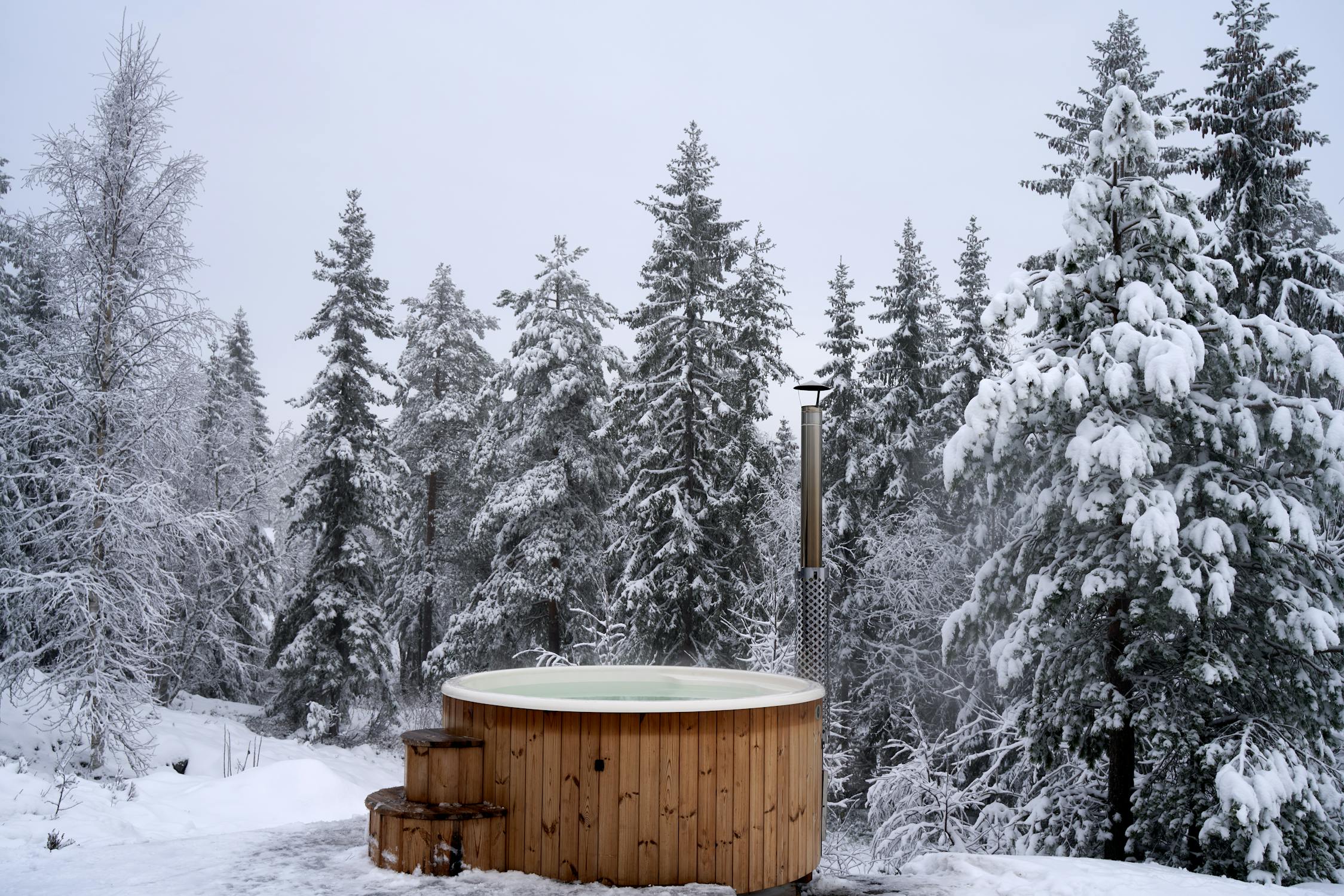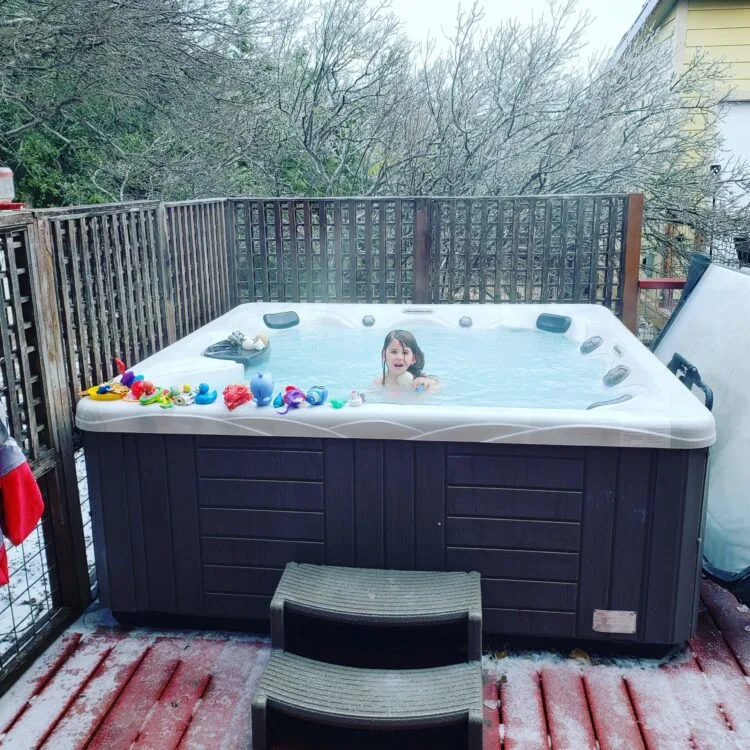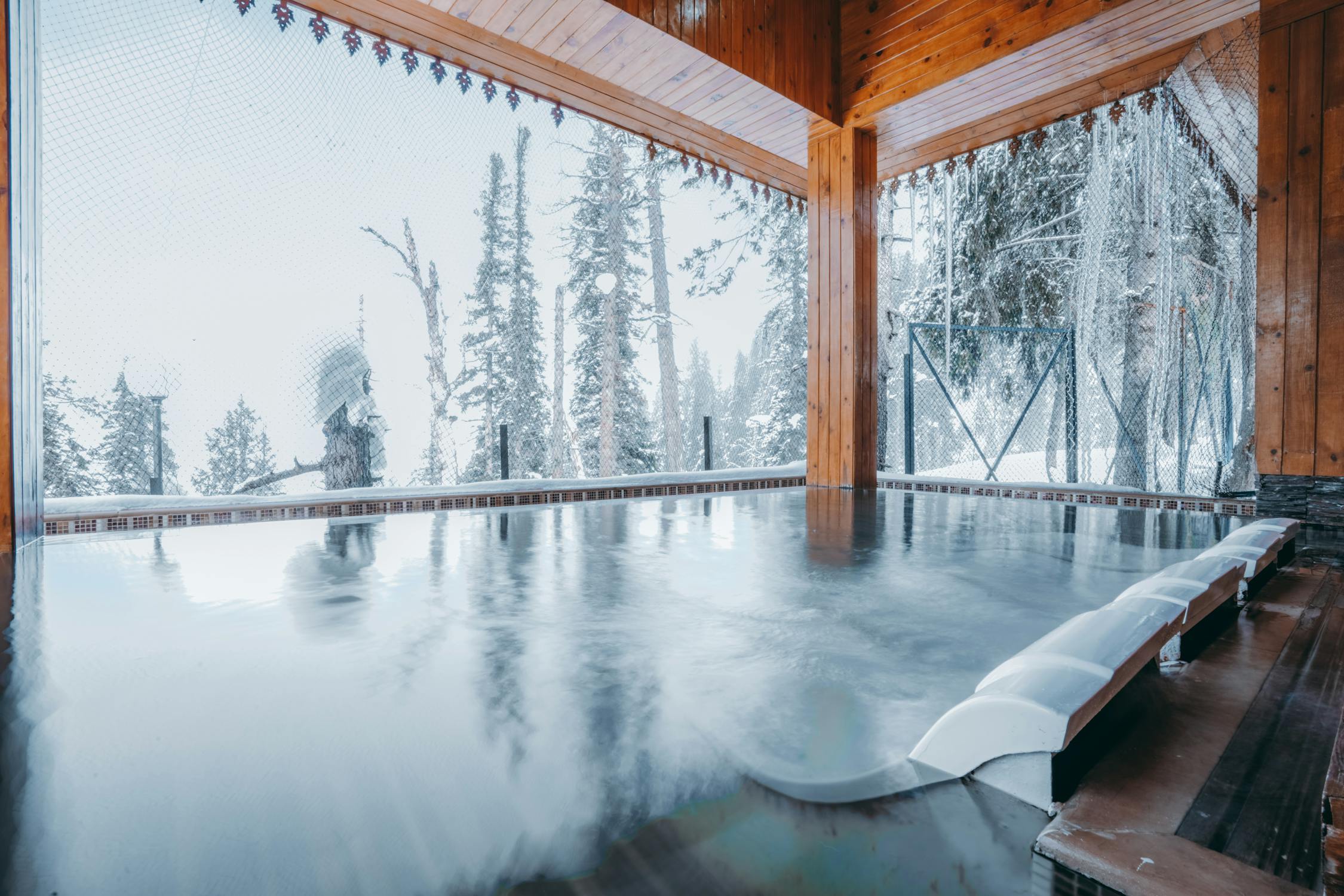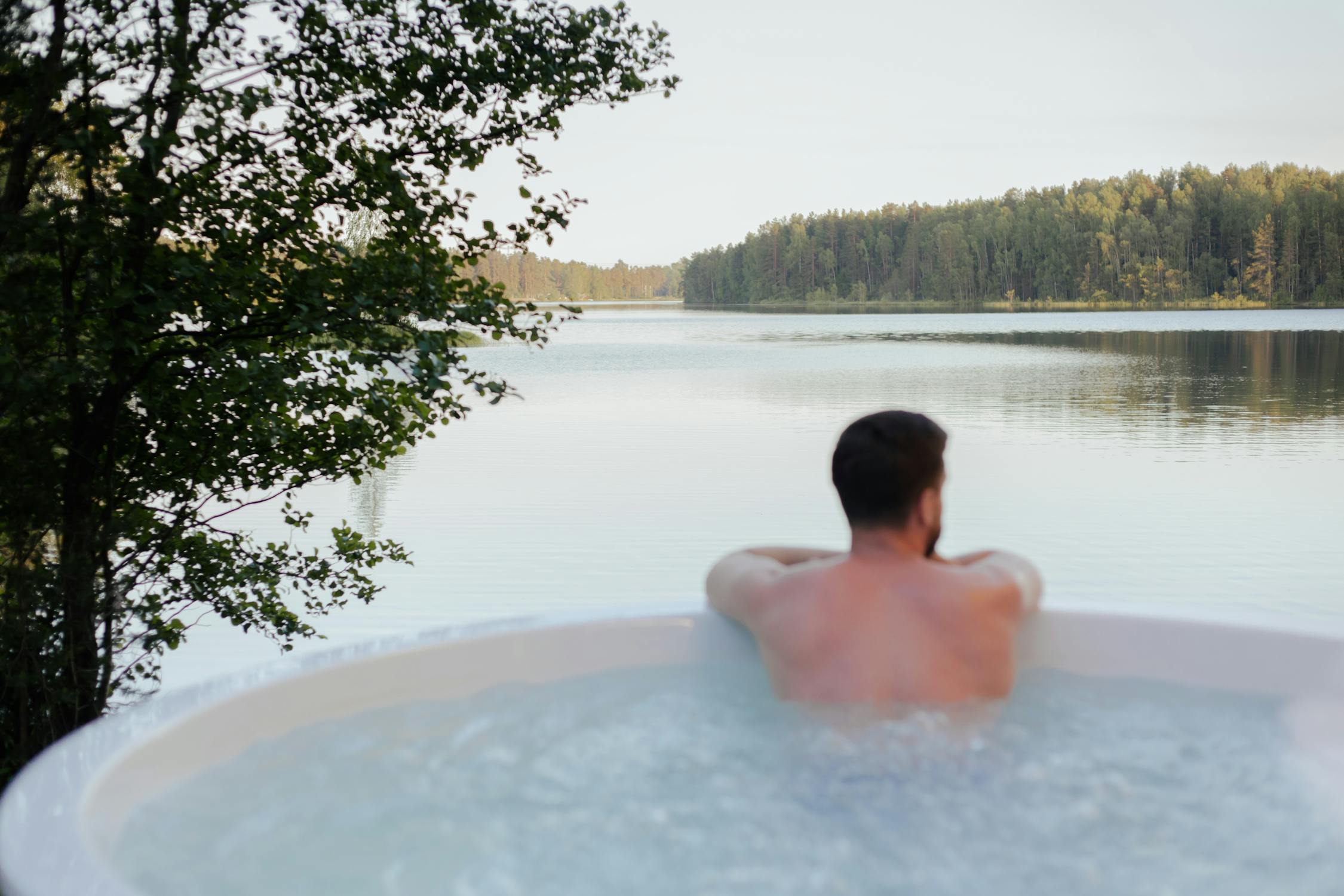Winter is here, and the thought of soaking in a warm, relaxing hot tub while the cold weather rages outside is undeniably appealing. But what is the best temperature for a hot tub in winter?
The recommended temperature for a hot tub in winter is 100-102°F (38-39°C). But if kids also use the hot tub, consider setting it between 98°F (36°C) and 100°F (37.78°C). This temperature range provides a comfortable and relaxing experience while still keeping you warm in colder weather.
It’s important to follow manufacturer and CDC guidelines and avoid temperatures above 104°F (40°C). And since I mentioned kids, remember the CDC does not recommend hot tub use for children under the age of 5.
This question is crucial not only for your comfort but also for your health and safety. In this blog post, we’ll guide you through the ideal winter hot tub temperature, factors affecting it, benefits, maintenance tips, and safety precautions to ensure you can enjoy your hot tub to the fullest during the colder months.
Short Summary
- The ideal winter hot tub temperature range is between 100-104°F (37-40°C).
- Proper insulation, energy-efficient heating systems, and regular monitoring are necessary to maintain a comfortable hot tub temperature in cold weather.
- Regular cleaning, water treatment, and protecting your hot tub from the elements in winter will help ensure its optimal performance.
Ideal Winter Hot Tub Temperature
The recommended comfortable hot tub temperature range during winter is between 100-104°F (37-40°C).
Adhering to these hot tub temperatures is essential as it can lead to potential health hazards if the water is too hot or too cold. To maintain the best hot tub temperature in most hot tubs, heat the spa to the desired level and leave the thermostat set once the spa is closed.
The hot tub temperature may decline during the winter season due to colder weather conditions or if the hot tub is situated outdoors, so it’s crucial to check your hot tub regularly for hot tub temperature low situations.
Various methods can expedite the increase of hot tub temperature, such as using pre-heated water, activating the jets, implementing a thermal blanket, maintaining the cover, and installing an immersion heater. To cool the water in the hot tub, you can either turn off the heater and allow the hot tub to cool naturally or employ a cooling system to reduce the water temperature.
Factors Affecting Winter Hot Tub Temperature
Several factors influence the winter hot tub temperature, such as ambient air temperature, insulation, and heating efficiency. Insulation plays a key role in preserving the heat of the hot tub, while the hot water temperature and cover contribute to sustaining the desired temperature.
Indeed, hot tub temperature matters when it comes to maintaining comfort and energy efficiency during colder months.
To ensure your hot tub maintains the ideal temperature during winter, it’s essential to invest in proper insulation, check your heating system’s efficiency, and monitor the ambient air temperature. Keeping these factors in check will help you fully enjoy your hot tub experience during the cold winter months.
Health Benefits of Winter Hot Tub Use
Utilizing a hot tub during the winter season can provide numerous health benefits, such as stress relief, improved circulation, and muscle relaxation.
The tranquil atmosphere of a hot tub releases endorphins, helping alleviate pain and reduce stress. Moreover, hot tub use in winter can enhance circulation by augmenting blood flow and assisting in recovery following physical activity by facilitating the alleviation of muscle soreness, especially in cooler temperatures.
However, it is essential to remember the safe hot tub temperature range and not exceed the maximum recommended temperature of 104°F (40°C). Prolonged exposure to higher temperatures can potentially result in hyperthermia, fainting, or even heat stroke, which could be fatal. (source)
Always be cautious and monitor your hot tub temperature to ensure a safe and beneficial experience.
Maintaining Your Hot Tub Temperature in Cold Weather

Maintaining your hot tub temperature in cold weather is essential for a comfortable and enjoyable experience.
Proper insulation, energy-efficient heating systems, and regular monitoring can help keep your hot tub at the desired temperature during winter. Moreover, maintaining your hot tub temperature can prevent common winter hot tub issues such as frozen pipes and fluctuating temperatures.
One effective method to maintain your hot tub temperature in cold weather is to use a hot tub cover to prevent heat loss and an aluminum cover to keep out debris, snow, and ice. Utilizing energy-efficient heating systems, such as heat pumps, solar heating systems, and gas heaters, can also help maintain your hot tub’s temperature and reduce energy costs.
Insulation and Heat Retention
Insulation and heat retention are essential for hot tubs during the winter season as they ensure the water is kept at a comfortable temperature while simultaneously decreasing energy expenditures. Investing in a high-quality hot tub cover significantly contributes to insulation and heat retention, as it helps to prevent heat loss and keep the water at the desired temperature.
Proper hot tub placement can also improve insulation and heat retention. Placing your hot tub away from cold winds and in a sheltered area will help keep the water warm and reduce heat loss. Combining this with a high-quality cover will ensure your hot tub stays cozy during the coldest months.
Floating Thermal Blanket
A floating thermal blanket is a good option for retaining heat in your hot tub during winter.
It acts as an insulating layer, minimizing heat loss and reducing energy consumption. It creates a barrier between the water and the colder air, helping to maintain the temperature of your hot tub.
Essentially it’s a custom-fit piece of bubble wrap that floats on the surface of the water.
By covering the surface, it prevents heat from escaping through evaporation and minimizes the direct contact between your body and the cooler air. Using a floating thermal blanket is one of the best ways to preserve the warmth of your hot tub and enjoy comfortable hot tubbing sessions even in colder temperatures.
Safety Precautions for Winter Hot Tub Use
It is crucial to follow safety precautions when using your hot tub in winter. Staying hydrated, limiting soak time, and monitoring body temperature are essential measures to prevent dehydration and heat-related health risks. Especially in the dry winter atmosphere, it is of great importance to remain hydrated while utilizing a hot tub during winter.
According to the Centers for Disease Control and Prevention (CDC), the temperature limit for hot tubs should not exceed 104°F (40°C) for health reasons. If the temperature is at the maximum recommended level, the duration of the hot tub use should be limited to 15 minutes at a time.
It is also important to monitor your body temperature, especially for vulnerable individuals such as heart patients, children, and pregnant women.
Hydration and Time Limits
When using your hot tub in winter, it’s essential to stay hydrated and follow the recommended time limits for soaking. Drinking plenty of water before, during, and after your hot tub session will help prevent dehydration and heat-related health issues.
Limiting your soak time to approximately 20 minutes, especially when the hot tub temperature is at the higher end of the recommended range, will also help reduce the risk of overheating and other health complications.
Monitoring Water Temperature
Monitoring your hot tub’s temperature is crucial for a safe and enjoyable hot tub experience, especially for those who are more susceptible to heat-related health risks. Utilize a floating thermometer or a wireless temperature monitor to keep track of your hot tub’s temperature while soaking in the hot tub as the digital readout isn’t always accurate.
By keeping an eye on your body temperature, you can avoid overheating, which can lead to dizziness, nausea, and other health complications.
Avoiding Slips Getting In or Out
During winter, avoiding slipping when getting in or out of a hot tub is a good idea, especially in cold climates.
Spa owners should take extra precautions to ensure safety. The good news is that there are several steps you can take to prevent slips and falls.
Clearing the area around the hot tub of snow, ice, or any other slippery substances is important.
Using non-slip mats or tread strips on the steps and the surrounding area can provide additional traction. Wearing appropriate footwear with a good grip is also recommended. By taking these precautions, you can enjoy your hot tub in winter without worrying about slipping hazards.
Winter Hot Tub Accessories

Investing in winter hot tub accessories can make your winter hot tub experience even more enjoyable while helping maintain temperature and reduce energy costs. Thermal covers and floating blankets are recommended accessories for this purpose. These accessories not only provide additional insulation, but also protect your hot tub from debris and contaminants, ensuring a clean and comfortable soak.
Thermal covers can be used to preserve the heat in the water, necessitating lower power consumption to reach the desired temperature. Floating blankets, on the other hand, provide an extra layer of insulation, reducing heat loss and evaporation while protecting the main cover from chemical damage.
By investing in these essential winter hot tub accessories, you can optimize your hot tub’s performance and enhance your soaking experience during the cold months.
Heavy-Duty Cover
A heavy-duty cover is an insulated cover that is designed to keep the hot tub water warm in winter. They aid in minimizing heat loss from evaporation and preserving the water at the desired temperature. Investing in a quality insulated cover is crucial for maintaining your hot tub’s temperature and reducing energy costs during winter.
A high-quality thermal cover can also protect your hot tub from debris, contaminants, snow, and ice, ensuring a pleasant and clean hot tub environment. By investing in a thermal cover, you can enjoy a cozy and energy-efficient hot tub experience throughout the winter season.
Floating Blankets
I mentioned these above. Floating blankets are designed to be placed below the cover floating on the water to provide an additional layer of insulation.
They help decrease heat loss and evaporation while safeguarding the main cover from chemical deterioration. Utilizing a floating blanket for a hot tub during the winter can reduce heat loss by up to 95%, making it an efficient method to retain heat and reduce heating costs.
To ensure the proper use and safety of a floating blanket, make sure it is trimmed to fit perfectly and not obstructing any jets or other components. Regularly inspect the floating blanket for signs of deterioration and replace it if necessary. Keeping the blanket clean and free of debris is also essential for maintaining its efficacy and prolonging its lifespan.
CLICK HERE to see my favorite floating thermal blanket on Amazon.
Troubleshooting Common Winter Hot Tub Issues

Encountering issues with your hot tub during winter is not uncommon.
Frozen pipes and fluctuating temperatures are common problems that can affect your hot tub’s performance and potentially cause damage. To maintain optimal performance and prevent damage, it’s essential to troubleshoot these issues and address their underlying causes.
Proper insulation, regular use, and maintaining a minimum temperature of 85-90°F can help prevent frozen pipes and components in your hot tub during freezing temperatures. Additionally, checking the thermostat, heating system, and insulation can help address fluctuating hot tub temperature issues.
By keeping an eye on these common winter hot tub issues, hot tub owners can ensure their hot tub remains in top condition throughout the season.
Frozen Pipes and Components
Frozen pipes and components can cause significant damage to your hot tub and lead to costly repairs.
To avoid frozen pipes and components in hot tubs during winter, it’s essential to run the jets intermittently to circulate the water. Luckily your normal filtration cycle should take care of this.
Also, utilize an extra thermal blanket underneath the cover, and maintain the spa cover in good condition. Monitoring the water level consistently and keeping the water balanced can also help prevent freezing issues.
By ensuring proper insulation, regular use, and maintaining a minimum temperature of 85-90°F, you can prevent frozen pipes and components in your hot tub and protect it from potential damage during the winter months.
What Do You Do With a Hot Tub in Winter During a Power Outage?
During a power outage in winter, it’s important to take certain steps to protect your hot tub.
First, ensure that the power to the hot tub is completely shut off. This will prevent any electrical damage once power is restored. Next, cover the hot tub tightly with a high-quality cover to insulate it and retain heat as much as possible.
If the outage is prolonged, periodically remove snow accumulation from the cover to prevent excessive weight. And it may also help to briefly stir the hot tub water to agitate it to prevent still water from freezing.
But temps would need to be below freezing for 2 or more days before the water would be in danger of freezing. With a gas stove, you could also heat water (but not boil) and add it to the hot tub to prevent freezing.
Finally, refrain from using the hot tub until power is restored to avoid any potential complications. By following these precautions, you can keep your hot tub safe and maintain its functionality during a winter power outage.
Fluctuating Hot Tub Temperature
Fluctuating hot tub temperature can be a frustrating issue during winter, but it can be addressed by checking the thermostat, heating system, and insulation.
Ensuring proper functioning and desired temperature setting of the thermostat is crucial. Examining the heating system for any signs of deterioration and ensuring it’s operating properly is also important.
Surrounding the cabinet of the hot tub with additional insulation is another effective way to prevent temperature fluctuations in the winter. Utilizing full foam insulation is the most energy-efficient insulation for hot tubs. By addressing these factors, you can maintain a consistent hot tub temperature and enjoy a comfortable soaking experience during the cold season.
I added simple foam panels that I cut to size to add insulation to my hot tub with the added benefit of noise reduction.
Winter Hot Tub Maintenance Tips

Proper maintenance of your hot tub during winter is essential for a safe and enjoyable experience.
Regular cleaning, water treatment, and protecting your hot tub from winter elements can help prolong its lifespan and maintain optimal performance. Draining and refilling the tub and activating freeze protection before the onset of winter is also recommended.
Investing in a quality insulated cover, sustaining the water temperature, preserving the water cleanliness, and monitoring the water level are all crucial maintenance tasks during winter. These tips will help you keep your hot tub in top condition, allowing you to fully enjoy its benefits throughout the colder months.
Regular Cleaning and Water Treatment
Regular cleaning and water treatment are essential for ensuring a safe and enjoyable hot tub experience. It is advisable to drain and refill your hot tub every 3-4 months in winter to maintain clean water and prevent bacteria and algae growth. Cleaning the shell, filters, and circulation pump filter is also important during the winter season.
To maintain water cleanliness, chlorine or bromine are generally the sanitizers of choice. Periodically examining the water and using a water treatment system will help ensure the cleanliness of the water and prevent health issues related to contaminated water.
Protecting Your Hot Tub from Winter Elements
Protecting your hot tub from winter elements, such as snow and ice, is essential to prolong its lifespan and maintain optimal performance. To prevent frozen pipes and components, monitor the water level and activate freeze protection. Ensuring your hot tub cover is in good condition and properly placed will also help protect your hot tub from debris, dirt, and winter weather.
To further shield your hot tub from winter elements, consider investing in a suitable cover that is constructed of robust material, such as vinyl or polyester, and tailored to fit your hot tub. Regularly checking the water level and temperature using a thermometer will also help you maintain a comfortable and safe hot tub experience during winter.
Summary
In conclusion, finding the best temperature for your hot tub in winter is essential for a safe, comfortable, and enjoyable experience.
By following the recommended temperature range, maintaining your hot tub’s insulation and heating efficiency, and taking safety precautions, you can fully enjoy the benefits of your hot tub during the cold months. Regular cleaning, water treatment, and protecting your hot tub from winter elements will ensure its optimal performance and prolong its lifespan.
Don’t let the winter weather keep you from enjoying your hot tub. By following these tips and advice, you can maintain the perfect temperature, protect your hot tub, and make the most of your relaxing winter soaks.
Frequently Asked Questions
What temperature should I keep my hot tub in the winter when not in use?
When not in use, it is best to keep your hot tub’s temperature at 95 degrees Fahrenheit in the winter, as this will save energy and help protect its internal system.
This temperature setting will also help to reduce the amount of time it takes to heat up the hot tub when you are ready to use it. But if you will not use it for a month or more during the colder months, consider winterizing your hot tub instead of just bumping the temperature down.
What temp is too cold for a hot tub in winter?
At 90°F (32°C), a hot tub temperature is too low and should not be used during the cold winter months; the recommended temperature for use is 95-98°F (35-36°C).
What temperature should I keep my hot tub at?
For a comfortable soak, it is recommended to set your hot tub temperature between 100°F (37.78°C) and 102°F (38.89) Temperatures above 104°F (40°C) can lead to heatstroke.
But if kids also use the hot tub, consider setting it between 98°F (36°C) and 100°F (37.78°C).
Should I run my hot tub in the winter?
Keeping your hot tub filled, heated, and ready for use in the Winter can make winter much more enjoyable. In fact, many look forward to the colder months specifically because they can enjoy their hot tub!
Hot tubs are a great way to relax and unwind, especially during the colder months. They provide a warm and inviting atmosphere that can help you escape the chill of winter. Plus, it’s free.
What are some energy-efficient heating systems for hot tubs?
When looking for energy-efficient heating systems for hot tubs, consider using heat pumps, solar heating systems, or gas heaters. Heat pumps are a great option as they are energy-efficient and can be used to both heat and cool the water. Solar heating systems are also a great option as they are cost-effective and can be used to heat the environment.
That being said, most hot tubs will not be easy to retro-fit.
As an Amazon Associate, I may earn a small commission from qualifying purchases if you click on Amazon from my site and choose to make a purchase. You can read my complete affiliate disclosure for more details.
- Relxtime 6 Person Square Inflatable Hot Tub (2024 Review) - March 11, 2024
- Hot Tub Cover Mold – Complete Cleaning Guide - February 20, 2024
- Hot Tub Heater Longevity: How Often Should You Replace? - December 14, 2023



